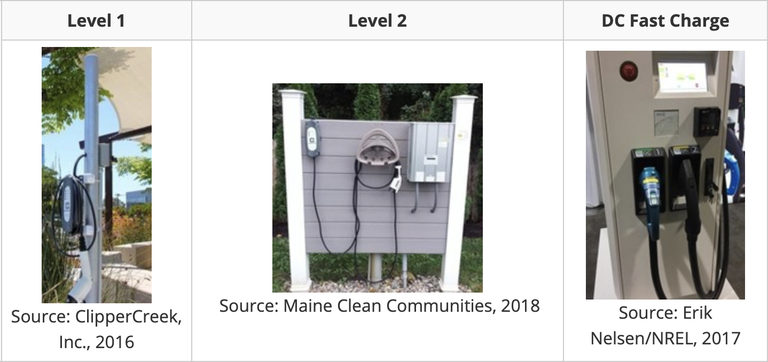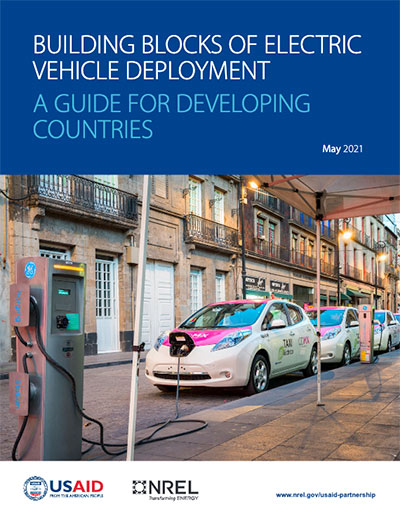Charging Infrastructure
Summary for Decision Makers
EV market development hinges on the availability of charging infrastructure, a key requirement that can be met in a variety of ways
Just as gasoline-powered vehicles demand an extensive network of petrol stations, so too do EVs require a widespread and reliable method of refueling. The apparatus of electric refueling is EVSE. One of the most important attributes of any EVSE is the level of power it provides when charging an EV. There are three major types of EVSE—Level 1, Level 2, and DC Fast Charging—each with different power characteristics. The location where people charge—home, work, public—also influence the type of EVSE used. And location, charging needs, and equipment all affect the types of business models used to invest and install EVSE. Sufficient and equitable access to EVSE is critical for catalyzing EV adoption.
Types of Charging
EVs can be driven for many different purposes, and so the spectrum of refueling needs is equally broad. According to Bennett (2019), Nicholas and Hall (2018), Rogge, Wollny and Sauer (2015), Shirk and Wishart (2015), and Pillai et al. (2018):
- Level 1 charging uses AC to deliver power using common household electricity standards. This results in low power loads (1–2 kW) and relatively longer EV charge times (»4 mi/6.4 km of light-duty vehicle range per hour of charging).
- Level 2 charging uses AC to deliver power using a specialized connection of higher voltage. These deliver between 6.6 kW and 19 kW of power, and charging rates of »25 mi/40 km of light-duty vehicle range per hour of charging, but many current EV models have an onboard limitation (“power acceptance rate”) that restricts charging to roughly half that rate in order to manage temperature and optimize battery life.
- DC Fast Charging (DCFC) uses DC to provide high power levels (i.e., 50–400 kW) using specialized charging equipment. Multiple DCFC standards exist, but all provide rapid charging (»180 mi/290 km of light-duty vehicle range per hour of charging). Another key consideration for DCFC is that not all vehicles can or should be fast charged. Some vehicles lack the proper connectors, and the high-power level of these EVSE can reduce the lifetime of some EV batteries.

Charging Location
Demands for EV refueling vary by location and influence equipment choices.
|
EVSE Location |
EVSE Type |
EV User and EVSE Owner |
Benefits |
Drawbacks |
|
Home |
L1, L2 |
Same |
Inexpensive electricity; convenient |
Not available in every housing situation; not viable for long journeys |
|
Workplace |
L1, L2 |
Different |
Predictable charging needs; can save costs if behind same meter as workplace |
Workplace must make investment decision; convenient during working hours only |
|
Public |
L1, L2, DCFC |
Different |
Meets charging needs for vacations, leisure activities, and EV users without other charging access |
Charging costs to EV user can be relatively higher than other EVSE locations; less predictable demand |
|
Fleet |
L2, DCFC |
Same |
Predictable charging needs; high potential for efficient electrification and fleet fuel cost savings |
High upfront cost; requires extensive planning |
Business Models
Different locations, charging needs, and equipment lead to a variety of EVSE ownership and investment models, which require a balance of public and private sector resources
Public and Private Sector Perspectives
In many countries and contexts, private firms will be leaders in the investment and deployment of EVSE because of the inherent business opportunities within electrified transport. EV users will require charging services, which private firms can provide for an acceptable and business-sustaining price. Following these incentives leads the private sector to deploy EVSE in situations where charging is sufficiently profitable, and to avoid deploying EVSE in unprofitable (or insufficiently profitable) situations. Private firms therefore will not make EVSE investments in communities or transportation corridors with few EV users or EV users unable to pay the price of charging. As a result, the charging network that arises from EVSE deployment led purely by the private sector may not match a country or city’s goals for electrified transportation. The government, or public sector, can choose to fill these gaps by incentivizing or subsidizing EVSE deployment in situations that may not be highly profitable to begin with, but that allow the overall EV market to grow larger, more quickly, and more equitably.
|
Charging Location |
Characteristics |
Type of Charger |
Business Model Considerations |
|
Residential |
Straightforward and common, but housing stock in many countries contains many multifamily homes and/or homes with a lack of plug-ready parking spaces |
L1 or L2 |
The private sector is less directly involved as the homeowner invests the necessary hardware and installation costs, then captures the benefits of refueling their EV in a convenient location at a low residential electricity rate. Residential charging becomes even more complex in rental units, where the landlord-tenant problem creates split incentives for the landlord, who must pay the costs of improvement, and the tenant, who receives the benefits. In these cases, the landlord may view EVSE as a renovation. |
|
Workplace |
Long dwell times; reliable travel patterns |
L1 or L2 |
Workplace charging infrastructure may be subject to a similar split incentive as rental housing if the business decides to invest in a benefit for its employees and assume responsibility for the maintenance and security of its EVSE. Businesses can decrease these cost burdens by placing the EVSE behind the same meter as the office’s electricity, which can help reduce the relative cost of utility demand charges for the EVSE. |
|
Public |
Less reliable travel patterns; variety and convenience of charging stations valued; may be only option for some EV adopters |
L1, L2, DCFC |
Charging locations such as highways, commuter corridors, or shopping centers can be key enablers of EV deployment. The potential value and convenience of charging stations in these public locations, for both easing range anxiety and enabling longer trips, can justify the higher charging prices required to offset the higher average installation costs of public EVSE due to distance from existing electrical infrastructure. |
|
Fleet |
Many vehicles; predictable routes |
L2, DCFC, on-route charging, catenary lines |
Fleets (whether privately or publicly owned) makes both the investment in EVSE and receives the benefits of EV charging services, most notably in the form of fuel cost savings. Fleet managers must also consider electricity rate structure, since the value of an EV fleet can be maximized by ensuring that the vehicles recharge using the least expensive rate available. The layout of the charging depot itself is also important for facilitating effective recharging of very high-usage fleets (e.g., buses). |
Battery Swap
A less-proven business model focuses on speedy refueling through a charging station that hosts many fully charged batteries. The company invests in charging stations and enough batteries to ensure availability for users. EV drivers can then swap their empty battery for a full one, for a fee. This model could be an elegant solution to range anxiety (i.e., the fear that the battery will run out of power before the destination is reached) and long refueling times, but the idea must overcome several obstacles to be successful. EV manufacturers must commit to producing models with easily swappable batteries, which can be a major design and intellectual property sacrifice. Drivers of freshly purchased EVs may also be reluctant to exchange their brand-new battery for ones of uncertain age and quality.
Equity Considerations
While every context is different, three overall categories of equity can be applied to EVSE deployment and business models: access, type, and price.
|
Equity Consideration |
Definition |
Example |
Effect |
Solution |
|
Access |
The population for whom EVSE is convenient to use |
If EV owners are mostly wealthy, single-family home owners, then the most profitable EVSE locations are in these same neighborhoods or the EV owners’ workplaces. The private sector is unlikely to deploy EVSE elsewhere because it will not return a sufficient profit. |
Lower-income EV consumers, or potential EV consumers in mixed-income neighborhoods, to decide against using EVs due to the lack of accessible charging infrastructure at home and work |
Public sector resources may be used for EVSE deployment to give marginal EV buyers confidence that they can access charging services. |
|
Type |
Relates to the diversity of EV models (truck, car, three-wheel, two-wheel, etc.) and the potential variety of charging and connector standards |
If EVs of a certain type (e.g. passenger vehicles) are more highly adopted than others (e.g. 2-wheelers) and can only be charged by a certain type of plug, then the most profitable EVSE will provide this popular charging service and not others. |
Limited EVSE networks for non-dominant vehicles that result in lower levels of adoption. |
Gap may be filled by public sector investment, or by setting charging and connector standards that allow many types of EVs to charge using the same equipment |
|
Price |
The cost of charging—a consideration for EVSE in less-utilized locations |
Charging station increases price of charging because it is not servicing enough EVs. |
Private firm increases revenues, but lower-income EV drivers cannot afford charging. |
Public sector policies or subsidies can support affordable charging prices.
|
Determining a “perfect” amount of EV charging infrastructure is complex; however, well-executed individual projects can add up to an effective system
Range anxiety and the overall accessibility of charging are primary concerns for potential EV adopters, and these factors drive EVSE deployment. At the same time, EVSE investors and developers are incentivized to seek the optimal location and highest demand for charging services, a selection process that can slow the pace of EVSE deployment. Governments may have justifiable concerns on the topic of “perfect” EVSE deployment—enough charging infrastructure to support the number of EVs on the road by keeping drivers secure and satisfied, but not so much as to incur unnecessary installation and grid upgrade costs by overbuilding. Optimizing EVSE deployment on this large scale is a complex exercise, and there are modeling tools available that can estimate these needs through consideration of the types of EVs to be served, charger type, population density, and other factors.
While this macro-planning approach has value for large-scale benchmarks and policymaker strategy, what matters most for successful EVSE deployment is that each project is carefully planned and executed based on real-world data. Private sector EVSE investors, national and state policymakers, and utilities should all coordinate to ensure that large-scale EVSE strategies can be realistically implemented.


